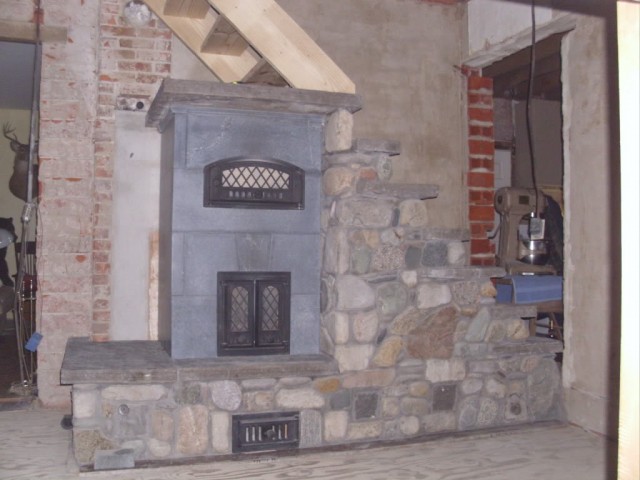By Dave Wilcox, Wilcox Masonry
I became interested in heaters about 20 years ago and always wanted one in my home but did not think I had the space for one. After building two heaters for some customers, joining the MHA, going to Wildacres and a workshop with Albie Barden, I finally built my heater. With a small house (1600 sqft two story), I ripped out my stairs and started the design. I already had a chimney beside the old stair case so it got ss liner.The wall behind the heater is 8†masonry perfect for thermal mass that can radiate heat to the living room.The nice thing about the location is I only lost a little closet space under the stairs.
 The heater has a 16×16 inch firebox and an oven. The down channel is behind the firebox and oven. The flue gases then enter a series of 4 bell chambers to the right, under the steps, and then through the horizontal channel back across the front hearth and heated bench to the chimney. The total length of the exhaust path is around 45 ft from firebox floor to chimney entrance; this part was inspired by Lars Helbro.
The heater has a 16×16 inch firebox and an oven. The down channel is behind the firebox and oven. The flue gases then enter a series of 4 bell chambers to the right, under the steps, and then through the horizontal channel back across the front hearth and heated bench to the chimney. The total length of the exhaust path is around 45 ft from firebox floor to chimney entrance; this part was inspired by Lars Helbro.
At cold start up burn the exhaust temp at chimney entrance 125 to 150 degrees f. The second burn 12 hr later creep up to 175. Then the third burn it max out at 250 to 275. Before I finished the facade I did a lot of test burns because I wanted to make sure every thing worked and it did.
I soon ran out of dry wood and found out why you don’t burn unseasoned wet green wood. I went to town and bought pellets. I built a box out of tin and perforated stainless steel to gasify the wood pellets in. The box was set over the cast iron grate and the bottom edge sealed against fire box floor. I had added fresh air intake in the sides of firebox that entered level with top of pellet box. Without the air intake at this level this would not have worked at all.
The burn started with a ½ “ layer of pellets in the bottom of box and lit with a torch. After they are ignited with good flames and embered up I pour the box ¾ full of pellets. Now you have hot wood gas, fresh air trough the grate, bottom up burn, then secondary air coming across the top of the pellet box , now combustion. The burn is very hot and clean and lasts about 20 minutes. The fire box did not get real hot but the oven and the rest of heater did fine. This is not the best fire box design for burning pellets but it did work. Max and I are talking about trying to come up with a better burn chamber for pellets to attach to some bells and benches. A pellet masonry heater and maybe stairs.
If you get a customer that wants a masonry heater but dose not want to give up any floor space, then rip out the stairs and build them a masonry heater staircase.
Further Reading:
- A great article by Norbert, Burning Pellets in a Masonry Heater.
